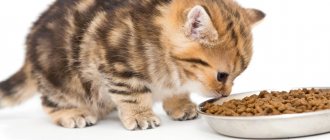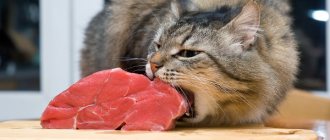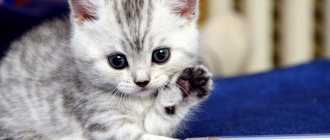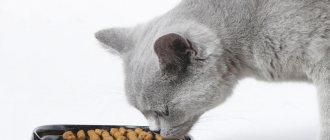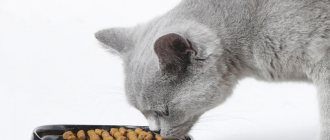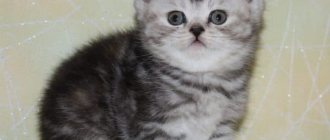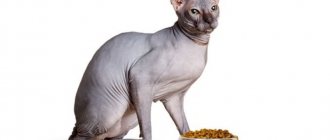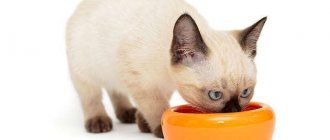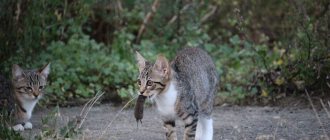Many people think that feeding a kitten is simple, because for centuries our ancestors in the villages simply gave the leftovers of dinner to their pets. It seems that it is enough to pour the remaining soup into a bowl, add a little meat or fish - and all this is enough for your pet. As a last resort, you can buy the most ordinary food in the store and not have to worry about choosing a menu. But everything is not so simple if you want your pet to be healthy, vigorous and live a long time. There are some nuances in creating a diet for kittens.
Feeding kittens without a cat
In the first days of life, mother's milk helps the kitten better adapt to new conditions. But it happens that babies are deprived of parental warmth early. You have to feed the kitten yourself. A special mixture that is sold in pet stores is suitable for this. It should be used to feed kittens in the first month after birth.
You cannot replace the mixture with cow's milk - it is permissible to use it only after a month, otherwise the kittens will develop diarrhea, and they may even die, because their stomachs are still very weak to digest complex food. It’s better to feed your baby goat’s milk for some time after using a mother’s milk substitute. This rule is relevant not only for purebred animals, but also for yard kittens.
For feeding, it is convenient to use a pipette or a bottle with a small nipple (all of this is also sold in pet stores). The second option is more preferable, since it is important to develop a sucking reflex in the baby. If it is not yet available, use a pipette to get a few drops of the mixture into the kitten's mouth, and then immediately apply it to the nipple - this way he will understand what needs to be done. In addition to the mixture, you can give the kitten warm water using a pipette or syringe.
Another option is to find a wet nurse. A cat that has recently given birth can feed a baby left without a mother.
Difficulties of parenting
The process of raising children cannot proceed calmly and measuredly. This contradicts the energetic essence of a growing organism, cognizing its environment, where absolutely everything is interesting. Therefore, you should not change the rules of its existence during the course of the action, as this will break the stereotype of the pupil’s behavior. Prohibitions must be established once and for all; they are unshakable and mandatory.
As the kitten continues to live in your home, you will have questions about why your pet is sneezing, has lost his appetite, and what to do when there is excessive salivation and hair loss.
If there is a violation in maintaining cleanliness, then you must first rule out the disease by contacting a specialist. If everything is in order, and the breakdowns continue, then under no circumstances should you “poke” the kitten’s nose into its Skoda or into the litter box, showing it in such a shameless manner where it should go for its needs. This will only scare him and develop a strong habit of hiding his flaws and hating his litter box. And the reason for this situation may be simple: you don’t like the smell of the filler or the place where the toilet is located.
Don’t be lazy to figure this out and don’t blame it solely on your pet. You must admit your mistakes and try to correct them as quickly as possible while there is still time for this. Your communication with your furry friend cannot be limited to basic procedures, feeding and games. It is a mistake to believe that a cat is not interested in “conversing” with you: communicate as often and as much as possible, she quickly picks up the intonations of the human voice and thanks to this develops her intelligence. Thus, you yourself become the “creator” of your pet’s character, and the more interesting it is, the more interesting it is for you.
Basic rules for feeding a newborn kitten
If the formula option is not suitable, try preparing food for your baby from milk and yolk. The components are taken in a 4:1 ratio and blended in a blender. You will get a thick mixture that needs to be diluted with water. The resulting product can be fed to newborn kittens. Just remember that chicken eggs must be fresh.
1 month
After the baby is 3-4 weeks old, you can include new foods in his diet. For the first complementary feeding, it is better to use products similar in composition to breast milk. For example, this is meat puree for children. They do not complicate digestion and are pleasant to the taste. You need to start with 1 meal a day, gradually increasing meals with new foods.
2 months
The diet doesn't change much. You can try including dry food in your diet. In addition to purees, you need to give your kitten solid food. The food does not need to be ground or chopped - the animal can handle it quite well. As the kittens grow, they will eat more. You can add cottage cheese, greens, pumpkin, porridge, cabbage, and raw yolk to your diet. These foods will help dry food digest better and reduce the likelihood of constipation. At this age, animals cannot yet control portions, and you need to make sure that they do not overeat. The first time, foods should be given in small quantities so that the body gets used to the new regime.
3 months
This is the period when babies' teeth begin to change. For their normal growth, you should include more solid food in your diet. It is acceptable to feed the kitten raw meat, but this will require additional use of deworming medications. Small bones will also work. By this age, the dosage is already clear to the animal, and he begins to eat in accordance with his appetite.
It is acceptable to include vegetables, boiled fish, cottage cheese, milk porridge, and yoghurt in the menu. And if previously the pet ate 8-10 times a day, now you can simply arrange 3 full meals. If you get used to this gradually, when the kitten is left at home alone, he will not go hungry.
5 months and older
You can give your pet food for adult animals. It is permissible to sprout grass that the kitten will eat from the flowerpot - it will help the food to be digested normally.
Feeding tips
When using natural food, it is important that the food is always fresh. The only possible exception is kefir. Also consider the following rules:
- animals should not be given smoked meats and pickles (even if these are meat or fish products);
- food should be warm, but not scalding;
- After each meal you need to wash the bowl;
- pieces that are too coarse need to be chopped even for an adult animal.
Natural: basic rules
When feeding homemade food, do not teach the animal to eat from the table, do not feed it leftover food during lunch. The kitten must understand where its bowl is located, and that food for it is located only in this place. Otherwise, you risk getting a beggar who will also steal food from the table.
Don't forget about vitamins that are important for a growing body. We also already talked about sprouting weed. Instead, you can plant wheat, the sprouts of which kittens are also very fond of.
Food basket
For a pet, you should buy beef, not pork, which is too fatty for a fragile body. Chicken, turkey, and sea fish are suitable. The latter is also good because it does not contain helminths that the kitten can become infected with. However, you shouldn’t even give sea fish too often - it’s enough to include it in the diet 1-2 times a week. Canned fish is also allowed, but due to the high salt content and high fat content, it is better to mix them with cereals.
Not all cats drink milk. Moreover, an older kitten does not need it; it is better to replace it with fermented milk products. If the kitten refuses this product, experiment with kefir and yogurt without additives. Control the fat content level - it is better to choose 2.5% options. Low-fat products are also not suitable due to the high sugar content in the composition.
Kittens love yolk and cottage cheese puree, sour cream, porridge with pieces of meat or vegetables, broths and soups. Just make sure that they do not contain legumes - this product is difficult to digest.
Ready-made feed
Often a certain breed of cat requires the use of artificial food. This method is also chosen by owners who are too busy and cannot constantly prepare food for their pet. Ready-made food has one important advantage - it already contains as many vitamins and minerals as the animal requires for normal development. It is better to accustom an animal to solid food gradually, starting with canned food.
Bosch Sanabelle wet food
This option belongs to the premium class and comes from Germany. Among the advantages, it is worth highlighting the balanced composition, in which the majority is animal protein, as well as the absence of artificial ones. However, the downside is that this food contains cellulose and maize - kittens are often allergic to these components. Therefore, it would be right to buy a small amount of food and see how your pet reacts to it.
Hills – food for kittens
This is another premium food that often has counterfeits, so buy it only in trusted stores. Among the advantages is a rich complex of vitamins and minerals. However, a high percentage of carbohydrates that are poorly absorbed by a growing body, a large amount of vegetable protein and a high likelihood of developing allergies are important disadvantages. There is also quite a lot of liquid in the package.
ProPlan Junior
This premium food is affordable, and many owners choose it. The brand is presented in many stores, and purchasing such food is not a problem. One of the advantages is the presence of probiotics in the composition, many types. But the product contains a lot of preservatives and vegetable protein.
Ready diet
Having given preference to a ready-made diet, when choosing food, take into account the age, activity level, breed, and individual characteristics of your furry pet. Choose high-quality “premium”, “super-premium”, “elite” products marked “For kittens”. These foods are made from high-quality ingredients and contain all the necessary nutrients for the growth and development of your pet.
The best ready-made food:
- Hills.
- Royal Canin.
- Eagle Pack.
- Nutra Gold.
- Eucada.
- Akana.
The line of many brands includes dietary, therapeutic and prophylactic food, food intended for a certain age and breed. For kittens with sensitive digestion, use food labeled “Holistic”.
Cheap "economy" food contains harmful dyes, taste stabilizers, preservatives, dyes, have low nutritional value and can cause food allergies and intestinal disorders. Don’t believe advertising and don’t skimp on your pet’s health.
When feeding with ready-made food, the diet does not need to be supplemented with vitamin complexes.
Before purchasing food, carefully study the information on the label and the manufacturer’s recommendations. For the convenience of owners, the approximate daily dose is already indicated on the packages, taking into account the age of the cats.
Products undesirable for kittens
Despite the fact that 20 years ago in villages cats were fed leftovers from dinner, and the animals did not have any problems with nutrition, modern pets have a more sensitive digestive tract.
In addition, they live in different conditions, and their immunity is not adapted to survive extreme situations. That is why it is better to exclude the following products from the animal’s diet:
- sausages, sausages, smoked meats;
- rice;
- bread and buns;
- margarine and butter;
- pasta;
- mushrooms and legumes;
- tomatoes;
- sweets.
Of course, nothing will happen to the kitten from one piece, but systematic consumption of such products will shorten the pet’s lifespan.
Dangerous foods for kittens
It is important to eliminate raw foods from your diet whenever possible. This is especially true for pork and river fish - they contain a lot of worms. It is better to boil and chop these products or replace them with lean meat and sea fish. You should also avoid seafood (shrimp, mussels).
Extremely dangerous products
Chocolate is very dangerous even for adult cats. Its consumption can cause the death of the animal. This product contains theobromine, which is absolutely not excreted from the cat’s body and accumulates in dangerous concentrations. The same applies to large bones, fragments of which can injure internal organs. It is strictly forbidden to give kittens expired food and medications prescribed for humans.
Also, depending on the breed, there may be certain dietary restrictions. For example, Maine Coons do not really like fish and digest it poorly, and Sphynx cats should not be given fatty foods.
What is forbidden to feed?
There are a number of foods that are contraindicated for feeding a one and a half month old kitten. First of all, these are sweet or salty foods, as well as foods with a lot of spices.
It is precisely because of the presence of these ingredients that food from the human table is absolutely not suitable for babies. In addition, the list of prohibited foods for kittens aged 1.5 months includes the following products:
- river fish – is a carrier of parasites;
- ready-made food of inappropriate gradation;
- dark chocolate;
- sweet fruits;
- raw egg white;
- bakery products.
You should absolutely not give your kitten chicken bones. This can lead to intestinal perforation. Poultry skin is also contraindicated due to its high fat content.
It is prohibited to consume products that have expired. The digestive system of babies is very sensitive and a low-quality product can cause severe poisoning and indigestion.
Basic rules of care
It is necessary to accustom the kitten to the bowl, not allowing him to take food in other places. Your pet may also refuse to eat from it if the container is dirty or inconveniently located. Therefore, make sure that the bowl is in a place where there are no drafts, or not on a walkway where household members could accidentally touch the kitten. The bowl needs to be washed regularly.
The play area and the feeding area should be located separately from each other so that the kitten does not spread leftover food around the room.
How many times a day should you feed a kitten?
Babies up to 3-4 months need to be fed 8-10 times a day due to the fact that their digestive system is still very weak and cannot digest a large amount of food at once. In the future, you can reduce the number of meals to 3-4 times a day.
Kitten food table
When creating a menu for small kittens, you can rely on the following table:
| Product | Can I give it to a kitten? |
| banana | No |
| borsch | No |
| broccoli | Yes |
| buckwheat | Yes |
| baby food | Yes |
| potato | No |
| semolina | No |
| carrot | Yes |
| cucumber | Yes |
| liver | Yes |
| ground meat | Yes |
| bread | No |
| egg | Yes |
| apple | Yes |
Vitamins and supplements
Until 6-8 months, kittens are actively growing and developing. If the pet is kept on natural food, the diet must be supplemented with complex, balanced vitamin and mineral supplements.
What vitamins and supplements are given to kittens? You can use fish oil, meat and bone meal, dry yeast, or ready-made vitamins and supplements that your veterinarian will recommend.
Remember, small kittens up to 4 months, as well as during the period of changing baby teeth, need proteins, essential acids, vitamins, and minerals.
With a ready-made diet, all useful substances are included in high-quality feed, so there is no need for additional vitamin or mineral complexes. Moreover, if your pet is not averse to eating raw vegetables and fruits, do not deny him this pleasure.
